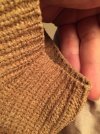I machine wash all my silk clothing. I use the delicate setting and cold water. I also throw them in the dryer on the low setting.
As a result, a lot my Wintersilks clothes have fallen apart. However, my other silk clothes are fine so far. I use Tommy Bahama long sleeve button up shirts and pants for work. The pants (90% silk) I bought new with large discounts (eg 60-75% off) online from places like Nordstrom Rack and Sierra Trading Post. The long sleeve shirts (100% silk) I bought used on ebay for under $20.
None of my Tommy Bahama silk clothes are shiny or super smooth, though they are much higher quality than smooth or shiny Wintersilks clothes.
As a result, a lot my Wintersilks clothes have fallen apart. However, my other silk clothes are fine so far. I use Tommy Bahama long sleeve button up shirts and pants for work. The pants (90% silk) I bought new with large discounts (eg 60-75% off) online from places like Nordstrom Rack and Sierra Trading Post. The long sleeve shirts (100% silk) I bought used on ebay for under $20.
None of my Tommy Bahama silk clothes are shiny or super smooth, though they are much higher quality than smooth or shiny Wintersilks clothes.

